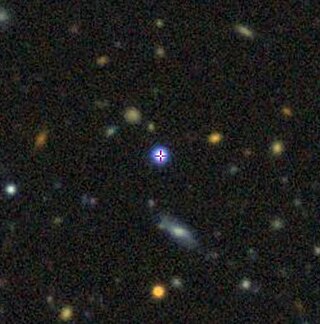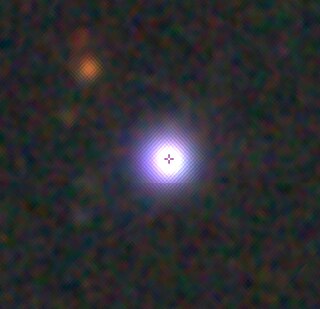
PKS 0438-436, also known as PKS J0440-4333, is a quasar located in constellation Caelum. With a high redshift of 2.86, the object is located 11.2 billion light-years from Earth and is classified as a blazar due to its flat-spectrum radio source, (in terms of the flux density as with α < 0.5 and its optical polarization.

PKS 2215+020, known as PMN J2217+0220, is a quasar located in the Aquarius constellation. Its redshift is 3.57, meaning the object is located 11.6 billion light-years away from Earth. It is classified as a flat spectrum radio source quasar.

PKS 2126-158, also known as PKS 2126-15, is a quasar located in Capricornus. It has a redshift of 3.268000, which corresponds to the distance of 11.5 billion light years. It is classified as a gigahertz peaked-spectrum quasar (GPS) with a flat-spectrum radio source and a blazar, a type of active galaxy shooting an astrophysical jet towards Earth.

PKS 0226-559 known as PMN J0228-5546 is a quasar located in the constellation Horologium. At the redshift of 2.464, the object is roughly 10.6 billion light-years from Earth.

PKS 0451-28, also known as MRC 0451-282, is a quasar located in the constellation of Caelum. Its redshift is 2.55, estimating the object to be located nearly 10.8 billion light-years away from Earth.

PKS 1144-379 also known as PKS B1144-379, is a quasar located in the constellation of Centaurus. At the redshift of 1.048, the object is located nearly 8 billion light-years from Earth.

PKS 1402+044 is a quasar located in the constellation of Virgo. It has a redshift of 3.207, estimating the object to be located 11.3 billion light-years away from Earth.

PKS 0805-07 also known as PMN J0808-0751 and 4FGL J0808.2-0751, is a quasar located in the constellation of Monoceros. With a redshift of 1.83, light has taken at least 10 billion light-years to reach Earth.

PKS 0405–385 is a blazar in the constellation of Eridanus. This is a compact radio quasar with a redshift (z) of 1.285, an indicator of its significant distance. The radio spectrum of this source appears flat, making it a flat-spectrum radio quasar (FSRQ).

PKS 0736+017 is a blazar located in the constellation of Canis Minor. This object is also a highly polarized compact radio quasar. Its source having a radio spectrum, appears to be flat, making it a flat spectrum radio quasar. It has a redshift of (z) 0.189 and is hosted in a large elliptical galaxy with a half light radius measurement of re = 13 kiloparsecs. The black hole mass in PKS 0736+017 is 7.32+0.89-0.91 x 107 Mʘ based on a full width at half maximum (FWHM) scaling factor and virial relation.

NRAO 530 or PKS 1730-13 is a flat-spectrum radio quasar located in the southern constellation of Serpens. It has a redshift of 0.902. and was first discovered by two astronomers, W.J. Welch and Hyron Spinrad in 1973. It is classified as a blazar because of its optical variability across the electromagnetic spectrum in radio, gamma ray and X-ray bands. This quasar is also further categorized an OVV quasar.

PKS 0208-512 is a blazar located in the southern constellation of Eridanus. It has a redshift of 1.003 and was first discovered in 1975 by astronomers conducting the Parkes 2700 MHz survey in Australia as a bright astronomical radio source. This object is also classified highly polarized with the radio spectrum appearing to be flat, thus making it a flat-spectrum radio quasar.

DA 193 is a blazar located in the constellation of Auriga. It has a high redshift of 2.365. It was first discovered as an unknown astronomical radio source in 1971 by D.G. MacDonell and A.H. Bridle. This is a low polarized quasar containing a classic homogeneous synchrotron self-absorption spectrum. The radio spectrum of this source shows a turnover frequency at 5 GHz and this object has also been referred to as a gigahertz-peak spectrum source.

PKS 1424-418 is a blazar located in the constellation of Centaurus. It has a redshift of 1.522 and was first discovered in 1971 by astronomer Keith Peter Tritton who identified the object as ultraviolet-excessive. This object is also highly polarized with a compact radio source. The radio spectrum of this source appears flat, making it a flat-spectrum radio quasar.

PKS 0537-441 is a blazar located in the constellation of Pictor. It has a redshift of 0.896 and was discovered in 1973 by an American astronomer named Olin J. Eggen, who noted it as a luminous quasar. This is a BL Lacertae object in literature because of its featureless optical spectra as well as both a possible gravitational microlensing and a gravitationally lensed candidate. Its radio source is found compact and is characterized by a spectral peak in the gigahertz range, making it a gigahertz-peaked spectrum source (GPS).

PKS 0420-014 is a blazar located in the constellation of Eridanus. This is a high polarized quasar with a redshift of (z) 0.915, first discovered as an astronomical radio source by astronomers in 1975. The radio spectrum of this source appears to be flat, making it a flat-spectrum radio quasar (FRSQ).

PKS 1622-297 is a blazar located in the constellation of Scorpius. It is one of the brightest objects of its type in the gamma ray region. It has a redshift of (z) 0.815. This blazar was first discovered as a compact astronomical radio source in 1970 by astronomers who were conducting interferometer observations and identified with an optical counterpart in 1984. In addition, the radio spectrum of the source appears flat, making it a flat-spectrum radio quasar (FRSQ).

PKS 0458-020 also known as PKS 0458-02, is a quasar located in the constellation of Orion. It has a redshift of (z) 2.286 and was first identified as an astronomical radio source during the radio survey conducted by Parkes Observatory in 1966. Subsequently the source was shown to display optical behavior before being classfied as a blazar via an optical polarimetry study in 1985. This source also shows radio spectrum appearing to be flat, hence making it a flat-spectrum radio quasar (FRSQ).

PKS 1510-089 is a blazar located in the constellation of Libra, categorized as a highly polarized quasar showing fast variations in polarization angles, with a redshift of (z) 0.361. It was first discovered in 1966 as an astronomical radio source during the Parkes Observatory survey in 1966. The radio spectrum of the source appears flat, thus making it a flat-spectrum radio quasar (FRSQ).

PKS 0454-234 is a blazar located in the constellation of Lepus. It is classified as a highly polarized quasar with a redshift of (z) 1.003. This object was first discovered in 1970 during a 1415 MHz continuum survey conducted by Ohio State University where it was given the designation, OF -292. The radio spectrum of this source is flat, making it a flat-spectrum radio quasar.




















